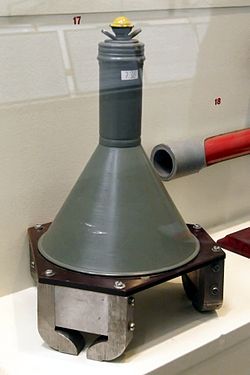Hafthohlladung
This article includes a list of references, related reading, or external links, but its sources remain unclear because it lacks inline citations. (December 2012) |

The Hafthohlladung, also known as the "Panzerknacker" ("Tank breaker", German connotation "Safe cracker") was a shaped charge anti-tank grenade used by German forces in World War II. The device is sometimes described as a mine, but as it is manually placed this is not correct terminology.
Details
The Hafthohlladung (lit. adhesive hollow charge) was primarily used by Wehrmacht tank killer squads. Designed with three magnets at the base, each with a pair of poles creating a strong magnetic field across their gap, infantryman could attach it to an enemy's tank no matter the angle of the surface. As the blast axis should be flush to the armour at the point of placement, and armed by pulling the igniter on the rear of the mine, the degree of a tank's sloped armour would be irrelevant for the device's penetration. However this required direct placement made use of the device very dangerous, as that infantryman would be highly vulnerable to enemy fire.
The Hafthohlladung device was very effective against armour, able to penetrate 140 mm of Rolled Homogeneous Armour (RHA). The H3 (3 kilogram) and H3.5 (3.5 kilogram) models are easily distinguishable; the H3 is bottle-shaped and H3.5 is conical.
Specifications
- Weight: 3 kg (H3 version) or 3.5kg (H3.5 version)
- First issued: November 1942
- Penetration: At 0°, 140mm of RHA or 508 mm (20") of concrete
- Fuse: Friction ignited, 4.5 second delay, later 7.5 seconds in May 1943
- Number Produced: 553,900
- Declared obsolete in May 1944 in favour of the Panzerfaust, but remaining stockpiles used until exhausted
